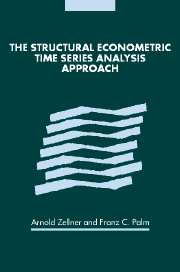Book contents
- Frontmatter
- Contents
- List of contributors
- Acknowledgments
- Introduction
- Part I The SEMTSA approach
- Part II Selected applications
- 6 Time series and structural analysis of monetary models of the US economy (1975)
- 7 Time series versus structural models: a case study of Canadian manufacturing inventory behavior (1975)
- 8 Time series analysis of the German hyperinflation (1978)
- 9 A time series analysis of seasonality in econometric models (1978)
- 10 The behavior of speculative prices and the consistency of economic models (1985)
- 11 A comparison of the stochastic processes of structural and time series exchange rate models (1987)
- 12 Encompassing univariate models in multivariate time series: a case study (1994)
- Part III Macroeconomic forecasting and modeling
- Part IV Disaggregation, forecasting, and modeling
- Subject index
- Author index
- References
6 - Time series and structural analysis of monetary models of the US economy (1975)
Published online by Cambridge University Press: 24 October 2009
- Frontmatter
- Contents
- List of contributors
- Acknowledgments
- Introduction
- Part I The SEMTSA approach
- Part II Selected applications
- 6 Time series and structural analysis of monetary models of the US economy (1975)
- 7 Time series versus structural models: a case study of Canadian manufacturing inventory behavior (1975)
- 8 Time series analysis of the German hyperinflation (1978)
- 9 A time series analysis of seasonality in econometric models (1978)
- 10 The behavior of speculative prices and the consistency of economic models (1985)
- 11 A comparison of the stochastic processes of structural and time series exchange rate models (1987)
- 12 Encompassing univariate models in multivariate time series: a case study (1994)
- Part III Macroeconomic forecasting and modeling
- Part IV Disaggregation, forecasting, and modeling
- Subject index
- Author index
- References
Summary
Introduction
In previous work, Zellner and Palm (1974), an approach for building and analyzing dynamic econometric models was presented that is a blend of recently developed time series techniques and traditional econometric methods. This approach was applied in analyzing dynamic variants of a small Keynesian macroeconometric model formulated by Haavelmo (1947). In the present chapter, we apply our approach in the analysis of variants of a dynamic monetary model formulated by Friedman (1970, 1971).
We commence our present analysis by presenting the structural equations of an initial variant of Friedman's model, denoted S0, that is viewed as a starting point for our analyses. That is, as in previous work we set forth a number of testable implications of S0, in particular the implications of S0 for the forms of the final and transfer equations for the variables of S0. Using monthly data for the US economy, 1953–72, and time series analysis, the implications of S0 are checked against the information in the data. As will be seen, some of S0's implications do not square with the information in the data. This leads us to consider other variants of the model whose implications can be checked with the data. In this way we attempt to iterate in on a variant of the model that is in accord with the information in the data. When a variant has been obtained that is in accord with the data information, it can be checked further with new sample information.
- Type
- Chapter
- Information
- The Structural Econometric Time Series Analysis Approach , pp. 243 - 287Publisher: Cambridge University PressPrint publication year: 2004
References
- 2
- Cited by



